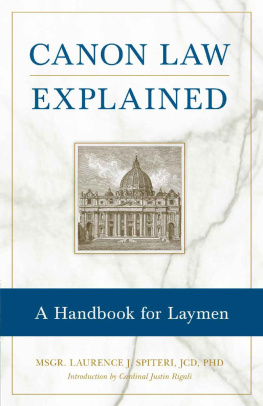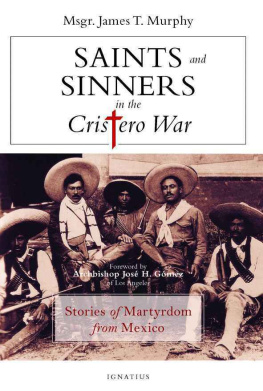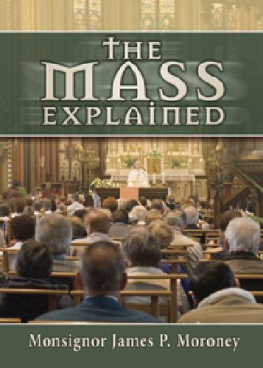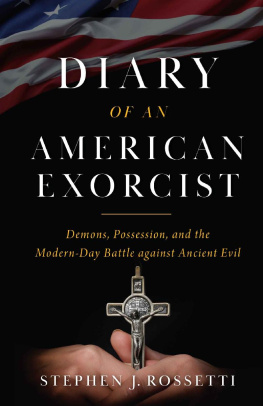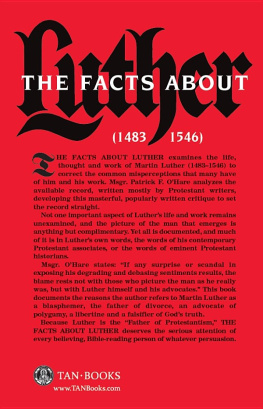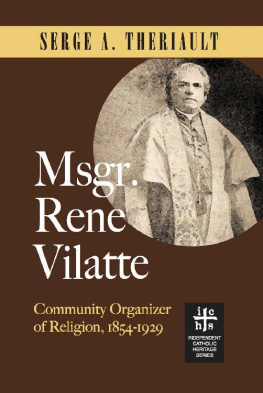Msgr. Laurence J. Spiteri - Canon Law Explained: A Handbook for Laymen
Here you can read online Msgr. Laurence J. Spiteri - Canon Law Explained: A Handbook for Laymen full text of the book (entire story) in english for free. Download pdf and epub, get meaning, cover and reviews about this ebook. year: 2014, publisher: Sophia Institute Press, genre: Religion. Description of the work, (preface) as well as reviews are available. Best literature library LitArk.com created for fans of good reading and offers a wide selection of genres:
Romance novel
Science fiction
Adventure
Detective
Science
History
Home and family
Prose
Art
Politics
Computer
Non-fiction
Religion
Business
Children
Humor
Choose a favorite category and find really read worthwhile books. Enjoy immersion in the world of imagination, feel the emotions of the characters or learn something new for yourself, make an fascinating discovery.
- Book:Canon Law Explained: A Handbook for Laymen
- Author:
- Publisher:Sophia Institute Press
- Genre:
- Year:2014
- Rating:5 / 5
- Favourites:Add to favourites
- Your mark:
- 100
- 1
- 2
- 3
- 4
- 5
Canon Law Explained: A Handbook for Laymen: summary, description and annotation
We offer to read an annotation, description, summary or preface (depends on what the author of the book "Canon Law Explained: A Handbook for Laymen" wrote himself). If you haven't found the necessary information about the book — write in the comments, we will try to find it.
Canon Law Explained: A Handbook for Laymen — read online for free the complete book (whole text) full work
Below is the text of the book, divided by pages. System saving the place of the last page read, allows you to conveniently read the book "Canon Law Explained: A Handbook for Laymen" online for free, without having to search again every time where you left off. Put a bookmark, and you can go to the page where you finished reading at any time.
Font size:
Interval:
Bookmark:
Canon Law Explained
A Handbook for Laymen
by
Monsignor Laurence J. Spiteri, JCD, PhD
Foreword by
His Eminence, Cardinal Justin Rigali,
Archbishop Emeritus of Philadelphia
SOPHIA INSTITUTE PRESS
Manchester, New Hampshire
Canon Law Explained was originally published as The Code in the Hands of the Laity in 1997 by Alba House, Staten Island, New York. This 2013 edition under the new title is a revised and updated version being published by Sophia Institute Press.
Copyright 1997; 2013 by Monsignor Laurence J. Spiteri
Vatican City State
Printed in the United States of America
All rights reserved
Cover design: Coronation Media in collaboration with Perceptions Design Studio.
On the cover: St. Peter Basilica (91579331) Hein Nouwens / Shutterstock.com; Marble Texture (60472279) sevda / Shutterstock.com.
No part of this book may be reproduced, stored in a retrieval system, or transmitted in any form, or by any means, electronic, mechanical, photocopying, or otherwise, without the prior written permission of the publisher, except by a reviewer, who may quote brief passages in a review.
The Nihil Obstat and Imprimatur are official declarations that the work contains nothing contrary to Faith and Morals. It is not implied thereby that those granting the Nihil Obstat and Imprimatur agree with the contents, statements, or opinions expressed.
Nihil Obstat : His Eminence, Cardinal Raffaele Farina, SBD, Censor
Imprimatur : His Eminence, Cardinal Angelo Comastri,
Vicar General for His Holiness, Pope Francis
Vatican City, July 1, 2013
Sophia Institute Press
Box 5284, Manchester, NH 03108
1-800-888-9344
www.SophiaInstitute.com
Sophia Institute Press is a registered trademark of Sophia Institute.
Library of Congress Cataloging-in-Publication Data
Spiteri, Laurence John, 1950- author.
[Code in the hands of the laity]
Canon law explained : a handbook for laymen / Rev. Laurence J. Spiteri, PhD, JCL ; foreword by Archbishop Justin Rigali of St. Louis.
pages cm
Originally published as The Code in the Hands of the Laity in 1997 by Alba House, Staten Island, New York.
Includes bibliographical references.
ISBN 978-1-622821-78-5 (pbk. : alk. paper) eBook ISBN 978-1-622821-79-2
1. Canon law Popular works. 2. Marriage (Canon law) Popular works. 3. Liturgies (Canon law) Popular works. 4. Catholic Church Government Popular works. I. Spiteri, Laurence John, 1950- Code in the hands of the laity. II. Title.
KBU160.S65 2013
262.9 dc23
2013038150
To Popes St. John XXIII and St. John Paul II
Contents
Foreword
Once again Monsignor Laurence J. Spiteri offers to the laity of the Church a useful guide to help them understand and appreciate Canon Law and its relationship to their daily lives. His new volume, Canon Law Explained , will make this important aim possible for the English-speaking public.
In reflecting on the law of the Church, which speaks of rights and duties, the lay faithful will have greater insights into the dignity and value of their own specific role in the Church.
It is my hope that the laity who read this new volume will find deep satisfaction in realizing that the laws of the Church affecting them reflect the rich teaching of Vatican II. According to this teaching, it is Jesus Christ himself who personally commissions the laity to their apostolate.
I am confident that this new work will bring about new enthusiasm and new commitment in many lay faithful.
Justin Cardinal Rigali
Bishop Emeritus of Philadelphia
September 12, 2013
Foreword to the 1997 Edition
Father Laurence Spiteri has worked with diligence and zeal in order to present to the laity a quick reference tool for a better understanding of the Code of Canon Law and the many canonical-pastoral issues that it deals with in the contemporary Church.
In his work, Father Spiteri has been inspired by the teaching of the Second Vatican Council on the dignity of the laity and on their calling to share actively in the life of Christs Church. He has shown how this spirit of Vatican II has indeed been captured by the Code of Canon Law, and this needs to be increasingly understood and lived by the laity.
A guiding principle in the present work is that the laity have been personally commissioned to the apostolate of the Church by the Lord Himself. Because of this, the Code of Canon Law, which regulates the pastoral activity of the Church, is extremely relevant for their Christian lives.
Following the Code, Father Spiteri tries to shed light on the Churchs life, on her institutions, and on her sacraments. His own personal zeal as a priest is seen in his desire to make the Church better known. Nowhere does Father Spiteri make a bigger effort to introduce his readers to the Churchs pastoral reality than in his treatment of matters affecting marriage. His pastoral sensitivity, gained from personal experience in assisting many persons involved in marriage cases, is an expression of the Churchs larger pastoral concern to proclaim the rights and duties of all Christs faithful and to help them live joyfully and effectively their discipleship of Jesus.
It is my hope that this work will indeed attain its aim, leading the laity to a better understanding of many of the canonical-pastoral realities of Christs Church, in which we all find salvation and life.
Justin Rigali
Archbishop of St. Louis
Solemnity of the Assumption
of the Blessed Virgin Mary, 1996
Introduction
Introduction
The original title of this book was The Code in the Hands of the Laity: Canon Law for Everyone. It was published by ALBA House / St. Pauls (New York) in 1997. I was informed a couple of years ago that the first edition had been depleted for a number of years.
I was very pleased when, in 2012, Sir Gareth N. Genner, then president of Holy Spirit College in Atlanta, Georgia, approached me with the proposal of publishing this book anew. He subsequently suggested that it be printed by Sophia Institute Press under a new title, Canon Law Explained . I am very grateful to both Sir Genner and Sophia Institute Press for being indispensably instrumental in putting this new edition into the readers hands.
It has been the practice of the Catholic Church down the centuries to reform and update her canonical discipline to make it more relevant to contemporary times as she remains faithful to the mission the Lord entrusted to her. These canons (laws) grew in time and were contained in diverse documents issued by different Popes, Ecumenical Councils, papal letters, canonical works, and a number of compilations. The dispersed canons were gathered together and codified for the first time under Popes St. Pius X and Benedict XV. The Code of Canon Law for the Latin Church was then promulgated in 1917. On the other hand, the canons for the Catholic of the Eastern Churches had to wait until 1990 for their codification in one specific tome.
Blessed Pope John XXIII (1958-1963) had been Pope for three months when, while visiting the Basilica of St. Paul Outside-the-Walls on January 25, 1959, he unexpectedly announced his intention to call a Synod of the Diocese of Rome, to convoke the Ecumenical Council, and to reform the 1917 Code. Subsequently, he established a Pontifical Commission for the revision of the Code on March 18, 1963. By this time, Vatican Council II (1962-1965) was already in session. The said Commission agreed that such a process could not start until the conclusion of the Council because there was no way to foresee what the Council Fathers would discuss and what the Magisterium would teach during the conciliar assembly. Furthermore, the Council unquestionably desired and requested the reform of the 1917 Code. Many Church scholars state that the successive 1983 Code is the last document of the Council. However, unlike the 1917 Code, the 1983 Code does not claim to contain all Church law because several subjects are not contained in it, such as the procedures for papal elections, and beatification and canonization processes.
Next pageFont size:
Interval:
Bookmark:
Similar books «Canon Law Explained: A Handbook for Laymen»
Look at similar books to Canon Law Explained: A Handbook for Laymen. We have selected literature similar in name and meaning in the hope of providing readers with more options to find new, interesting, not yet read works.
Discussion, reviews of the book Canon Law Explained: A Handbook for Laymen and just readers' own opinions. Leave your comments, write what you think about the work, its meaning or the main characters. Specify what exactly you liked and what you didn't like, and why you think so.

